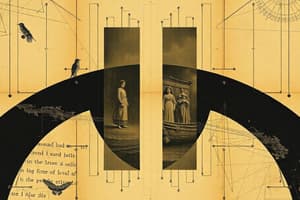Podcast
Questions and Answers
Which of the following BEST describes the function of an 'e-mail'?
Which of the following BEST describes the function of an 'e-mail'?
- A program included with most browsers.
- A protocol for transferring files over the internet.
- The transmission of messages and files via a computer network. (correct)
- A storage location usually resembling a mailbox.
What is the PRIMARY purpose of an 'e-mail address'?
What is the PRIMARY purpose of an 'e-mail address'?
- To filter unwanted messages.
- To identify a user and a domain name for electronic communication. (correct)
- To store a list of names and addresses.
- To ensure secure file transfer.
An 'Address Book' is used for what purpose?
An 'Address Book' is used for what purpose?
- To manage files on an FTP server.
- To maintain a collection of names and e-mail addresses. (correct)
- To store frequently accessed website URLs.
- To moderate newsgroup content.
Which of these options describes 'Mailbox' in the context of email?
Which of these options describes 'Mailbox' in the context of email?
What role does a 'Mail server' play in email communication?
What role does a 'Mail server' play in email communication?
What is the function of Post Office Protocol 3 (POP3)?
What is the function of Post Office Protocol 3 (POP3)?
Which statement accurately describes File Transfer Protocol (FTP)?
Which statement accurately describes File Transfer Protocol (FTP)?
What distinguishes Anonymous FTP from regular FTP?
What distinguishes Anonymous FTP from regular FTP?
In the context of online communication, what is a 'Newsgroup'?
In the context of online communication, what is a 'Newsgroup'?
What is the main function of a 'News server'?
What is the main function of a 'News server'?
A 'Newsreader' is primarily used for what purpose?
A 'Newsreader' is primarily used for what purpose?
What does a 'Thread' or 'Threaded discussion' generally consist of?
What does a 'Thread' or 'Threaded discussion' generally consist of?
What is the defining characteristic of 'Mailing Lists'?
What is the defining characteristic of 'Mailing Lists'?
What is the primary function of 'CHAT' in the context of online communication?
What is the primary function of 'CHAT' in the context of online communication?
What does 'Real Time' mean in the context of online communication?
What does 'Real Time' mean in the context of online communication?
Which of these options best describes the function of a 'Chat room'?
Which of these options best describes the function of a 'Chat room'?
What functionality is provided by 'Voice chats and video chats'?
What functionality is provided by 'Voice chats and video chats'?
What is generally included in 'Chat client'?
What is generally included in 'Chat client'?
What is the main purpose of 'Instant Messaging (IM)' services?
What is the main purpose of 'Instant Messaging (IM)' services?
How do IM services typically notify users of contact availability?
How do IM services typically notify users of contact availability?
Flashcards
E-Mail
The transmission of messages and files via a computer network.
E-mail Address
E-mail Address
The combination of a user name and a domain name that defines a user's email address.
FTP Site
FTP Site
A collection of files including text, graphics, audio, video, and program files that reside on a FTP server.
Newsgroup
Newsgroup
Signup and view all the flashcards
Chat Room
Chat Room
Signup and view all the flashcards
CHAT
CHAT
Signup and view all the flashcards
Study Notes
Matrices
Basic Definitions
- A matrix $A$ is a table of numbers with $m$ horizontal rows and $n$ vertical columns.
- $A$ is represented as: $A = \begin{bmatrix} a_{11} & a_{12} & \cdots & a_{1n} \ a_{21} & a_{22} & \cdots & a_{2n} \ \vdots & \vdots & \ddots & \vdots \ a_{m1} & a_{m2} & \cdots & a_{mn} \end{bmatrix}$
- An alternate representation is $A = (a_{ij})_{m \times n}$.
- The size of the matrix is $m \times n$.
- An element is a single number $a_{ij}$.
- Index $i$ indicates the horizontal row and $j$ indicates the vertical column.
- A square matrix has an equal number of rows and columns $m = n$.
Example
- An example of a $2 \times 3$ matrix is: $A = \begin{bmatrix} 1 & 2 & 3 \ 4 & 5 & 6 \end{bmatrix}$
Matrix Addition and Scalar Multiplication
- Matrices $A$ and $B$ are the same size if they have the same number of horizontal and vertical rows
- Matrices of the same size can be added together.
- For $A = (a_{ij}){m \times n}$ and $B = (b{ij}){m \times n}$, $A + B = (a{ij} + b_{ij})_{m \times n}$.
- A matrix can be multiplied by a real number (scalar).
- If $A = (a_{ij}){m \times n}$ and $c \in \mathbb{R}$, then $cA = (ca{ij})_{m \times n}$.
Example
- $\begin{bmatrix} 1 & 2 \ 3 & 4 \end{bmatrix} + \begin{bmatrix} 5 & 6 \ 7 & 8 \end{bmatrix} = \begin{bmatrix} 1+5 & 2+6 \ 3+7 & 4+8 \end{bmatrix} = \begin{bmatrix} 6 & 8 \ 10 & 12 \end{bmatrix}$
- $2\begin{bmatrix} 1 & 2 \ 3 & 4 \end{bmatrix} = \begin{bmatrix} 2 \cdot 1 & 2 \cdot 2 \ 2 \cdot 3 & 2 \cdot 4 \end{bmatrix} = \begin{bmatrix} 2 & 4 \ 6 & 8 \end{bmatrix}$
Physics
Vectors
Vector Sum
Analytical Method
- Vector components are $\overrightarrow{A} = A_x\hat{i} + A_y\hat{j}$
- $A_x = A \cos \theta$
- $A_y = A \sin \theta$
- The resultant vector is $\overrightarrow{R} = \overrightarrow{A} + \overrightarrow{B} = (A_x + B_x)\hat{i} + (A_y + B_y)\hat{j}$
- $R_x = A_x + B_x$
- $R_y = A_y + B_y$
- Magnitude of resultant vector is $R = \sqrt{R_x^2 + R_y^2}$
- Angle is $\theta = \tan^{-1} (\frac{R_y}{R_x})$
Scalar Product (Dot Product)
- $\overrightarrow{A} \cdot \overrightarrow{B} = AB \cos \theta$
- $\overrightarrow{A} \cdot \overrightarrow{B} = (A_x\hat{i} + A_y\hat{j}) \cdot (B_x\hat{i} + B_y\hat{j}) = A_xB_x + A_yB_y$
Vector Product (Cross Product)
- $\overrightarrow{A} \times \overrightarrow{B} = AB \sin \theta \hat{n}$
- $\overrightarrow{A} \times \overrightarrow{B} = (A_x\hat{i} + A_y\hat{j} + A_z\hat{k}) \times (B_x\hat{i} + B_y\hat{j} + B_z\hat{k}) = (A_yB_z - A_zB_y)\hat{i} + (A_zB_x - A_xB_z)\hat{j} + (A_xB_y - A_yB_x)\hat{k}$
- $\overrightarrow{A} \times \overrightarrow{B} = \begin{vmatrix} \hat{i} & \hat{j} & \hat{k} \ A_x & A_y & A_z \ B_x & B_y & B_z \end{vmatrix}$
Kinematics
Uniform Rectilinear Motion (MRU)
- $v = \frac{\Delta x}{\Delta t} = \frac{x_f - x_i}{t_f - t_i}$
- $x_f = x_i + v(t_f - t_i)$
Uniformly Varied Rectilinear Motion (MRUV)
- $a = \frac{\Delta v}{\Delta t} = \frac{v_f - v_i}{t_f - t_i}$
- $v_f = v_i + a(t_f - t_i)$
- $x_f = x_i + v_i(t_f - t_i) + \frac{1}{2}a(t_f - t_i)^2$
- $v_f^2 = v_i^2 + 2a(x_f - x_i)$
Free Fall and Vertical Throw
- $a = -g = -9.8 m/s^2$
- $v_f = v_i - g(t_f - t_i)$
- $y_f = y_i + v_i(t_f - t_i) - \frac{1}{2}g(t_f - t_i)^2$
- $v_f^2 = v_i^2 - 2g(y_f - y_i)$
Oblique Throw
- $v_{0x} = v_0 \cos \theta$
- $v_{0y} = v_0 \sin \theta$
- $x_f = x_i + v_{0x}(t_f - t_i)$
- $y_f = y_i + v_{0y}(t_f - t_i) - \frac{1}{2}g(t_f - t_i)^2$
- $v_{fx} = v_{0x}$
- $v_{fy} = v_{0y} - g(t_f - t_i)$
- Time to reach max height $t_{v} = \frac{v_{0y}}{g}$
- Total time of flight $t_{total} = 2t_v = \frac{2v_{0y}}{g}$
- Maximum horizontal distance $x_{max} = \frac{v_0^2 \sin 2\theta}{g}$
- Maximum height reached $y_{max} = \frac{v_0^2 \sin^2 \theta}{2g}$
Uniform Circular Motion (MCU)
- Angular velocity $\omega = \frac{\Delta \theta}{\Delta t}$
- Tangential velocity $v = \omega r$
- Centripetal acceleration $a_c = \frac{v^2}{r} = \omega^2 r$
- Period $T = \frac{2\pi r}{v} = \frac{2\pi}{\omega}$
- Frequency $f = \frac{1}{T} = \frac{\omega}{2\pi}$
Uniformly Varied Circular Motion (MCUV)
- Angular acceleration $\alpha = \frac{\Delta \omega}{\Delta t}$
- $\omega_f = \omega_i + \alpha(t_f - t_i)$
- $\theta_f = \theta_i + \omega_i(t_f - t_i) + \frac{1}{2}\alpha(t_f - t_i)^2$
- $\omega_f^2 = \omega_i^2 + 2\alpha(\theta_f - \theta_i)$
Studying That Suits You
Use AI to generate personalized quizzes and flashcards to suit your learning preferences.



